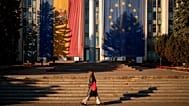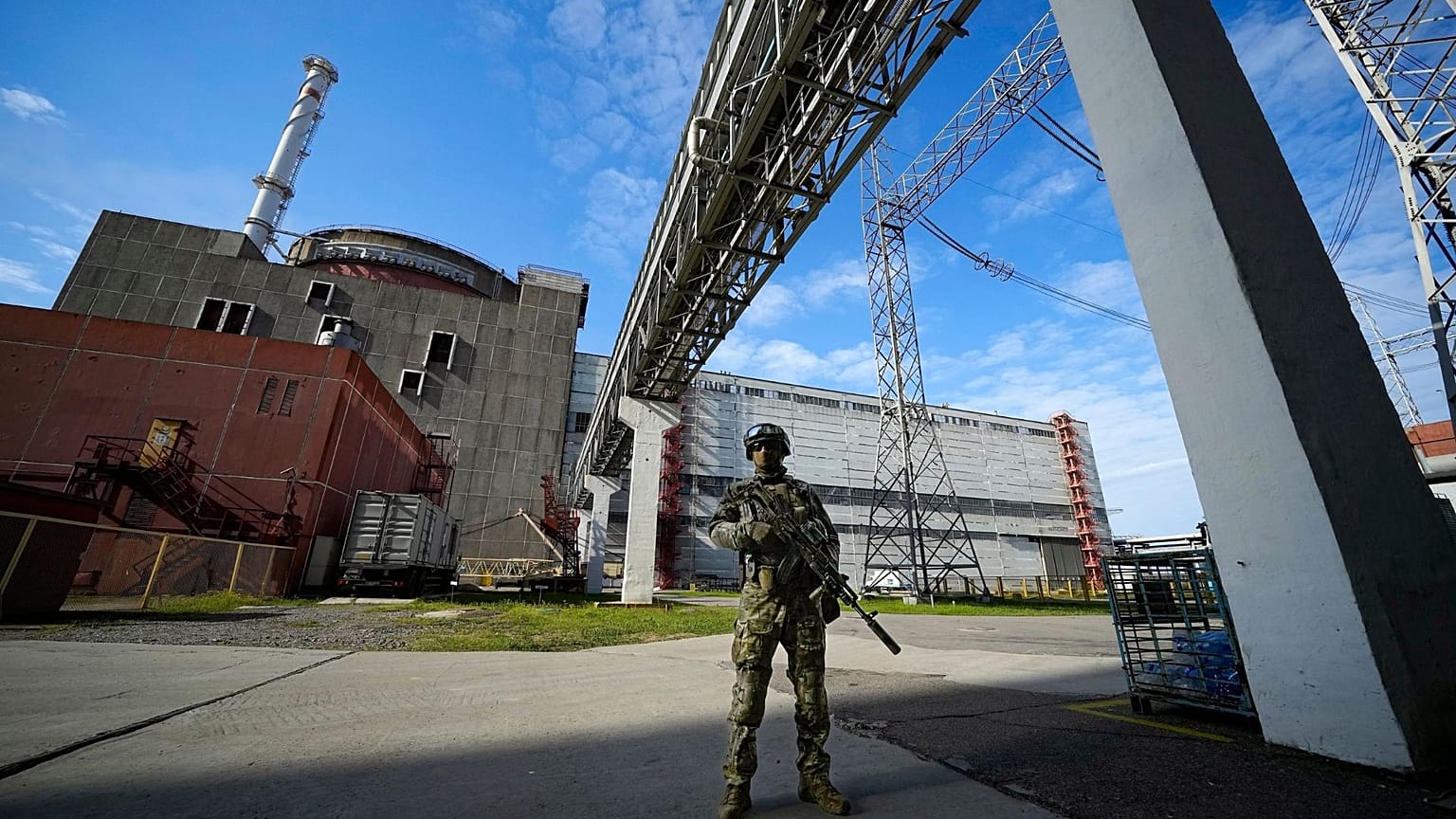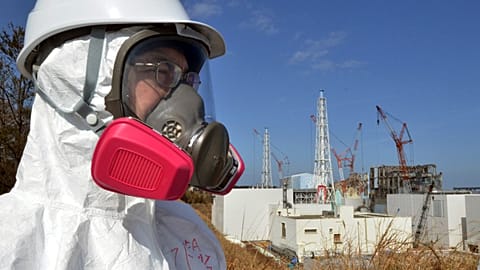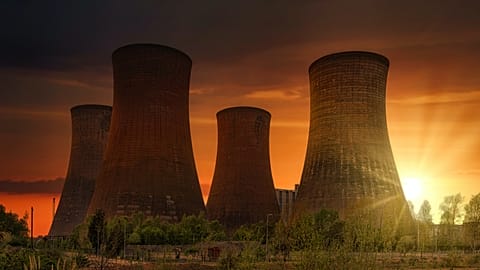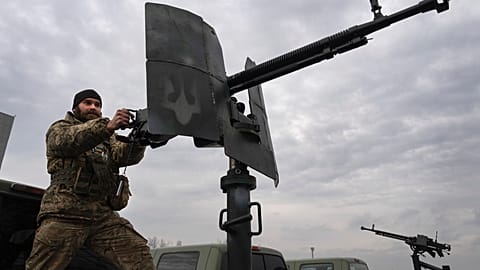The UN has repeatedly voiced concerns since Russian forces took over the Zaporizhzhia nuclear plant last year, Europe’s largest.
 ADVERTISEMENT
ADVERTISEMENT
Russia’s invasion has repeatedly knocked out Ukraine’s electricity grid, causing blackouts at the Zaporizhzhia nuclear plant - Europe’s largest - where a constant power supply is needed to prevent the reactors from overheating.
On March 9, the plant blacked out for the sixth time since the occupation, forcing nuclear engineers to switch to emergency diesel generators to power its essential cooling equipment running.
"Each time we are rolling a dice,” Rafael Mariano Grossi, the director general of the United Nations’ International Atomic Energy Agency (IAEA), warned at the time. “And if we allow this to continue time after time, then one day, our luck will run out".
On March 27, during a meeting with Ukraine’s president Volodymyr Zelensky, Grossi reiterated the situation “isn’t getting any better” as relentless fighting in the area keeps the facility at risk of a disaster.
The IAEA watchdog has called for a “protection zone” around the plant but has failed to devise terms that would satisfy both Ukraine and Russia.
Grossi told the AP on March 28 he believed a deal was "close". However, Zelenskyy, who opposes any plan that would legitimise Russia’s control over the facility, said he was less optimistic a deal was near. “I don’t feel it today," he said.
“I understand Zelenskyy's scepticism,” said Jan Haverkamp, a senior nuclear energy and energy policy expert for Greenpeace.
“If the IAEA is able to broker a deal, it will have to take care that all Russian military and interfering Rosatom [Russia’s nuclear Energy Corporation] personnel will leave the site, and that it is handed back to Ukrainian safety control and that security is secured by independent or Ukrainian forces,” he told Euronews Next.
“I do not see that happening soon”.
Is Zaporizhzhia really at risk?
Nuclear power plants are designed to withstand a wide range of risks, but no operating nuclear power plant has ever been caught up in modern warfare.
Because of the repeated crossfire, Zaporizhzhia’s last reactor was shut down in September as a precautionary measure. But external power is still essential to run critical cooling and other safety systems.
One critical reality to consider with respect to the risks of nuclear plant disasters is that “these catastrophes don't respect political borders. And because of how large-scale radiation release is affected by prevailing winds, it is very difficult to predict how far and to where the radiation will be dispersed,” said American scholar and disaster-medicine expert Dr Irwin Redlener.
“A major meltdown at Zaporizhzhia would be a catastrophe for Europe- and, ironically, for western Russia as well,” he told Euronews Next.
Nothing we could possibly do in the aftermath of such a calamity would be as effective as preventing it from occurring in the first place”.
Fears about Zaporizhzhia have all but exacerbated existing concerns around our lack of preparedness for any nuclear-related incident, laying bare anxieties not necessarily around war-related incidents but about climate change and Europe's old reactors, for instance.
It raises the question, too, of whether we should rely on nuclear power at all.
March 11 marked the 12-year anniversary of the massive earthquake and tsunami that caused the second-worst nuclear accident in history at the Fukushima Daiichi Nuclear Power Plant in Japan.
The anniversary of the catastrophic meltdown that left 160,000 people displaced and cost the Japanese government over €176 billion, was another reminder of the potential threat of a nuclear spill, but a number of other recent events have also raised the alarm in Europe, not least the war in Ukraine.
'We are not properly prepared'
Europe’s nuclear power reactors are ageing - they were built on average 36.6 years ago - and recent checkups in France have found cracks in several facilities.
Some energy experts have warned that the extreme weather events brought on by climate change could pose a serious threat to the EU’s 103 nuclear reactors, which account for about one-quarter of the electricity generated in the bloc.
Haverkamp said the chances of Europe seeing a large accident like Fukushima were now "realistic" and "we should take them into consideration".
"We are not properly prepared," he said.
European Commissioner for Energy Kadri Simson says the backbone of the EU’s future carbon-free power system will be renewables supported by nuclear.
"The reality is that these renewables will need to be complemented with a stable baseload electricity production. This is why nuclear energy is […] a real solution,” she said in November at the 15th European Nuclear Energy Forum.
The challenge with the strategy to power renewables with nuclear energy is that it relies on the continued operation of ageing nuclear plants.
Five of the six scenarios in the "Energies of the Future Report" - a study commissioned by the French Government - propose that to transition to a net-zero energy system by 2050, renewables would need to be reliant on a number of existing nuclear power plants.
The logic for using old plants is that "we cannot make sufficient reactors before that time," Haverkamp explained.
France’s Nuclear Safety Authority (ASN) agrees: "The rate of construction of new nuclear reactors in order to achieve the proposed scenario [...] would be hard to sustain," it said in a 2021 report.
“Over the last 70 years of use of nuclear power, it has become very clear that nuclear power does not fulfil its promises, but it is rather a large problem, very substantial to the direction of nuclear proliferation… and on the issue of radioactive waste, for which we have no acceptable technical solution,” Haverkamp said.
Are nuclear plants safe?
The ASN says a "good level" of nuclear safety and protection against radiation can only be achieved if the nuclear licensees fully assume their responsibility for it.
In other words, it is the plant operators, under the supervision of independent national regulators, who are primarily responsible for the safety of their installations.
The maintenance of a nuclear plant depends on a number of factors, such as its design and its supervision history. But there are other factors that come into play, such as error-prone humans, earthquakes, tsunamis, fires, flooding, tornadoes or even in the case of Zaporizhzhia, acts of war.
The Fukushima disaster in 2011 involved a nuclear plant that was over 40 years old, and the accident was attributed in part to design flaws and inadequate safety measures.
Upgrades for ageing plants can reduce the risk in certain aspects, Haverkamp said, “but there is still a risk: it can go wrong, simply because they continue to operate”.
France has one of the best nuclear safety records in the world. However, Bernard Doroszczuk, the head of its nuclear safety watchdog, said earlier this year that a “systemic review” was needed “to examine and individually justify the ability of the older reactors to continue to operate beyond 50, or even 60 years” while also allowing to anticipate new challenges posed by climate change.
In early March, the French electricity supplier EDF reported "non-negligible" defects in the cooling pipes of two reactors in northern and eastern France.
The cracks, located in the emergency circuit that injects water to cool the system in case of emergency, were not deemed dangerous because the reactors were undergoing maintenance, but their discovery has revived debates about France’s strategies to supervise its nuclear fleet.
How safe are people living around nuclear plants?
There is one other element in nuclear safety that is particularly important: the density of populations around nuclear facilities. Areas inhabited by millions of people are far more complex to evacuate than nearly deserted ones.
Following the Fukushima accident in March 2011, Declan Butler, a journalist for the scientific journal Nature, teamed up with NASA and Columbia University on a study comparing population densities around the world's nuclear power plants.
At the time Butler published his study, two-thirds of the world's nuclear fleet had a bigger population density within a 30-kilometre radius than Fukushima, where 172,000 people lived at the time of the spill.
Specifically, the study found that the population densities around nuclear reactors were much higher in Europe than they were around Fukushima.
In France, for example, Butler estimated that around 930,000 people lived in a 30-km radius around Fessenheim, just one of several plants located in the country’s northeast, and 700,000 people lived around the Bugey plant, 35 km east of Lyon, France's third-largest city.
As he tried to make sense of some safety incongruencies, Butler also came across the concept of ”beyond design basis,” a notion that implies that some catastrophic scenarios are not fully considered in the design process because they are deemed too unlikely.
The Fukushima Daiichi plant, for example, was located in an area designated as having a relatively low chance of a large earthquake and tsunami on Japan's seismic risk map. The fact that the plant was not prepared to deal with such dramatic environmental hazards was therefore partly due to "beyond design basis": the earthquake and tsunami were more powerful than the plant was designed to withstand.
Have we learned anything from Chernobyl and Fukushima?
Haverkamp said that efforts have mostly focused on technical preparedness to prevent nuclear accidents, but not on emergency preparedness or population preparedness.
“Every nuclear country in the EU, I fear, at this moment has insufficient preparedness in case it would come to an accident,” he said.
"And I can guarantee you if we would have an accident in Europe, it would end up in chaos again, just as it did in Fukushima”.
Redlener agrees. We did learn a lot from Fukushima; he said, "the thing is, we talk about the lessons, but then we don't act on them."
Humanity has gotten better at responding to small emergencies like big building fires, small storms, and blizzards, but when it comes to large-scale disasters - such as nuclear incidents - our abilities to respond remains "dysfunctional," he explained, "because we're not prepared for them".
"We are victims of "random acts of preparedness […] with no cohesive plan," he added.
Several international organisations provide resources that explain what to do in the event of a nuclear emergency. The Red Cross is just one of them - and reviewing their recommendations is a sensible use of your time.
After, all, there are two things that stand in the way of global preparedness, said Redlener. The first is what he calls "the illusion of safety," and the other is "disengaged, uninformed citizens".
The illusion of safety or "preparedness theatre," he said, is the fantasy that "somehow we know what we are doing, or that we know what we will do" when faced with such a catastrophic event.

